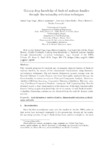Gaining deep knowledge of Android malware families through dimensionality reduction techniques

Use this link to cite
http://hdl.handle.net/2183/31878Collections
- Investigación (EPEF) [594]
Metadata
Show full item recordTitle
Gaining deep knowledge of Android malware families through dimensionality reduction techniquesAuthor(s)
Date
2019-04Citation
Rafael Vega Vega, Héctor Quintián, José Luís Calvo-Rolle, Álvaro Herrero, Emilio Corchado, Gaining deep knowledge of Android malware families through dimensionality reduction techniques, Logic Journal of the IGPL, Volume 27, Issue 2, April 2019, Pages 160–176, https://doi.org/10.1093/jigpal/jzy030
Abstract
[Abstract] This research proposes the analysis and subsequent characterisation of Android malware families by means of low dimensional visualisations using dimensional reduction techniques. The well-known Malgenome data set, coming from the Android Malware Genome Project, has been thoroughly analysed through the following six dimensionality reduction techniques: Principal Component Analysis, Maximum Likelihood Hebbian Learning, Cooperative Maximum Likelihood Hebbian Learning, Curvilinear Component Analysis, Isomap and Self Organizing Map. Results obtained enable a clear visual analysis of the structure of this high-dimensionality data set, letting us gain deep knowledge about the nature of such Android malware families. Interesting conclusions are obtained from the real-life data set under analysis.
Keywords
Android malware
Malware families
Dimensionality reduction
Artificial neural networks
Malware families
Dimensionality reduction
Artificial neural networks
Editor version
Rights
This is a pre-copyedited, author-produced version of an article accepted for publication in Logic Journal of the IGPL following peer review. The version of record: Rafael Vega Vega, Héctor Quintián, José Luís Calvo-Rolle, Álvaro Herrero, Emilio Corchado, Gaining deep knowledge of Android malware families through dimensionality reduction techniques, Logic Journal of the IGPL, Volume 27, Issue 2, April 2019, Pages 160–176, is available online at: https://doi.org/10.1093/jigpal/jzy030
ISSN
1368-9894





